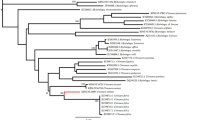Summary
The connective epineural sheath of the abdominal mass ganglia of the land snail Cryptomphallus aspersa was studied by light and electron microscopy. In this sheath several cellular types were found: fibroblasts, macrophage cells, a special type rich in mitochondria; elongated cells which proved to be muscle cells of paramyosin type and glial cells with dense bodies in close contact with neurosecretory axons. Special attention was paid to the filaments of the muscle cells. Thin and thick ones were found, the last with cross bands with a repeating period of 150 Å. These findings are discussed in relation with the physiological role of the epineural connective sheath in metabolic and mechanical functions.
Similar content being viewed by others
References
Benjamin, P. R., and A. Peat: Myoneural junctions in the connective tissue sheath of a molluscan ganglion. Nature (Lond.) 219, 1371–13720 (1968).
Chalazonitis, N.: Chemopotentials in giant nerve cells. In: Nervous inhibition (E. Florey, ed.), p. 179–193. New York: Pergamon 1961.
Coggeshall, R. E.: A light and electron microscope study of the abdominal ganglion of Aplysia californica. J. Neurophysiol. 30, 1263–1287 (1967).
—, and D. W. Fawcett: The fine structure of the central nervous system of the leech Hirudo medicinalis. J. Neurophysiol. 27, 229–289 (1964).
Eales, N. B.: Aplysia. Proc. Trans. Liverpool Biol. Soc. 35, 183–226 (1921).
Fernández, J.: Nervous system of the snail Helix aspersa. I. Structure and Histochemistry of ganglionic sheath and neuroglia. J. comp. Neurol. 127, 157–182 (1966).
Gerschenfeld, H. M.: Observations on the ultrastructure of synapses in some pulmonate molluscs. Z. Zellforsch. 60, 258–275 (1963).
Hanson, J., and J. Lowy: Evidence for sliding filament contractile mechanism in tonic smooth muscles of Lamellibranch molluscs. Nature (Lond.) 180, 906–909 (1959).
—: Structure and function of the contractile apparatus in the muscles of invertebrates animals. In: Structure and function of muscle (G. H. Bourne, ed.), vol. 1, p. 265–330. New York: Academic Press 1960.
Hanson, J., and J. Lowy: The structure of F actin and of actin filaments isolated from muscle. J. molec. Biol. 6, 46–60 (1963).
Havet, J.: Contribution a l'étude de la neuroglie des invertébrés. Trab. Lab. Inv. Biol. Univ. Madrid 14, 35–43 (1916).
Hess, A.: The fine structure of nerve cells and fibers, neuroglia, and sheaths of the ganglion chain in the cockroach (Periplaneta americana). J. biophys. biochem. Cytol. 4, 731–742 (1958).
Hoyle, G.: High blood potassium in insects in relation to nerve conduction. Nature (Lond.) 169, 281–282 (1952).
—: Potassium ions and insect nerve muscle. J. exp. Biol. 30, 121–135 (1953).
Lowy, J., and J. Hanson: Ultrastructure of invertebrate smooth muscles. Physiol. Rev. 42 (Suppl. 3), 34–47 (1962).
Nisbet, R. H.: Some aspects of the structure and function of the nervous system of Archachatina marginata. Proc. roy. Soc. B 154, 267–278 (1961).
Pellegrino de Iraldi, A., and E. de Robertis: Electron microscope study of a special neurosecretory neuron in the nerve cord of the earthworm. Proc. V Int. Congr. for Electron Micr. New York: Academic Press 1962.
Reynolds, E. S.: The use of lead citrate at high pH as an electron opaque stain in electron microscopy. J. Cell Biol. 17, 208–212 (1963).
Rosenbluth, J.: Pine structure of epineural muscle cells in Aplysia californica. J. Cell Biol. 17, 455–460 (1963).
—: Ultrastructural organization of obliquely striated muscle fibers in Ascaris lumbricoides. J. Cell Biol. 25, 495–515 (1965).
—: Obliquely striated muscle. III. Contraction mechanism of Ascaris body muscle. J. Cell Biol. 34, 15–33 (1967).
Scharrer, B.: The differentiation between neuroglia and connective tissue sheath in the cockroach Periplaneta americana. J. comp. Neurol. 70, 77–88 (1939).
Schlote, F. W.: Submikroskopische Morphologie von Gasteropodennerven. Z. Zellforsch. 45, 543–568 (1957).
Schmitt, F. O., R. S. Bear, C. E. Hall, and M. A. Jakus: Electron microscope and X-ray diffraction studies of muscle structure. Ann. N. Y. Acad. Sci. 47, 799–848 (1947).
Spiro, D., and M. Hagopian: On the assemblage of myofibrils. In: Formation and fate of cell organelles (K. B. Warren, ed.). Symposia of the Int. Soc. for Cell Biology, vol. 6, p. 71–98. New York: Academic Press 1967.
Spurlock, B. O., C. Victoria, Kattine, and J. A. Freeman: Technical modifications in Maraglas embedding. J. Cell Biol. 17, 203–207 (1963).
Strumwasser, F.: Neurally induced contraction of nerve trunks in Aplysia. Physiologist 4, 118 (1961).
Trujillo-Cenóz, O.: Some aspects of the structural organization of the arthropod ganglia. Z. Zellforsch. 56, 649–682 (1962).
Trump, B. F., E. A. Smuckler, and E. P. Benditt: A method for staining epoxy sections for light microscopy. J. Ultrastruct. Res. 5, 343–348 (1961).
Wigglesworth, V. B.: The histology of the nervous system of an insect, Rhodnius prolixus. II-The central ganglia. Quart. J. micr. Sci. 100, 299–313 (1959).
—: The nutrition of the central nervous system in the cockroach Periplaneta americana. The role of perineurium and glial cells in the mobilization of reserves. J. exp. Biol. 37, 500–512 (1960).
Author information
Authors and Affiliations
Additional information
From the Departamento de Ciencias Biológicas, Facultad de Farmacia y Bioquímica, Universidad de Buenos Aires, Argentina.
Associated Investigator, Consejo Nacional de Investigaciones Científicas y Técnicas, Argentina.
The authors are deeply indebted to Professor Eduardo de Robertis for the valuable advice during the preparation of the manuscript and to Mrs. Defilippi-Novoa and Mr. Raúl Castelli for their skilful assistance.
Rights and permissions
About this article
Cite this article
Sanchis, C.A., Zambrano, D. The structure of the central nervous system of a pulmonate mollusc (Cryptomphallus aspersa). Z. Zellforsch. 94, 62–71 (1969). https://doi.org/10.1007/BF00335190
Received:
Issue Date:
DOI: https://doi.org/10.1007/BF00335190




